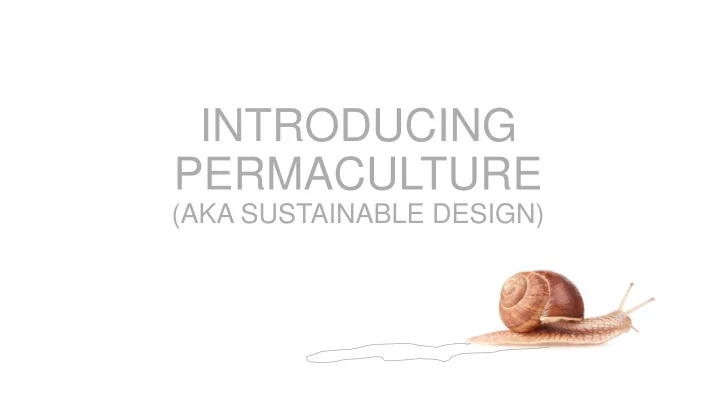

INTRODUCING PERMACULTURE (AKA SUSTAINABLE DESIGN)
WHAT IS PERMACULTURE? PERMANENT + AGRICULTURE = PERMACULTURE
THE STORY OF PERMACULTURE • Founded by Bill Mollison , an Australian ecologist, in 1972 • Mollison met David Holmgren , one of his students, and together they formed the original concept of permaculture • Permaculture has now made its way across the globe • It continues to become popular among farmers, gardeners, and environmentalists
WHAT IS PERMACULTURE? • PERMACULTURE: a design process and ideology based on whole-systems thinking informed by design principles found in nature • Permaculture-based designs mimic the patterns and relationships found in nature and can be applied to all aspects of the human world • Agriculture, ecological building, technology, education, economics, philosophy, and probably more! • Used primarily for agriculture
WHY? • By adopting these principles and practices, we can move away from being dependent consumers and transition into becoming responsible producers • Beyond sustainability • Creates a more sustainable lifestyle and future , where households and communities can rely on each other • Growing food and beautiful spaces requires less human labor and produces less waste
WHY? • By adopting these principles and practices, we can move away from being dependent consumers and transition into becoming responsible producers zero waste • Beyond sustainability • Creates a more sustainable lifestyle and future , where households and communities can rely on each other • Growing food and beautiful spaces requires less human labor and produces less waste
THREE ETHICS Earth care Fair share People care
PEOPLE CARE We need to look after ourselves and after others. There is a need to companionship and collaborative efforts to make positive change. We can grow as people through self-reliance and personal responsibility.
EARTH CARE We need to rebuild natural capital. We need to care for life on Earth. A functioning Earth is in our self-interest, as well as in the self-interest of other life forms.
FAIR SHARE We need to set limits and redistribute surplus . Because we have access to ample resources, we are obligated to share with others. There are limits on how much we can give and take, however.
PERMACULTURE PRINCIPLES 1. Observe and Interact 7. Design from Patterns to Details 2. Catch and Store Energy 8. Integrate rather than Segregate 3. Obtain a Yield 9. Use Small and Slow Solutions 4. Apply Self-Regulation 10. Use and Value Diversity and Accept Feedback 11. Use Edges and Value the 5. Use and Value Marginal Renewable Resources and Services 12. Creatively Use and Respond to Change 6. Produce No Waste
PERMANENT AGRICULTURE • "Permaculture (permanent agriculture) is the conscious design and maintenance of agriculturally productive ecosystems which have the diversity, stability, and resilience of natural ecosystems.” • Goals: • Improve soil quality and structure • Emphasis on perennials and fruit trees • Low maintenance, sustainable food production • Closed-loop system • High diversity
PERMACULTURE METHODS • Food forest • Guild building • Sheet mulching • Bioswales • Hugelkulture • Herb spiral • Keyhole designs
SHEET MULCHING PRODUCE NO WASTE CAPTURE AND STORE ENERGY
HERB SPIRAL
HUGELKULTURE
GUILD BUILDING/ COMPANION PLANTING
FOOD FOREST
KEYHOLE DESIGN
BIOSWALE USE EDGES AND VALUE THE MARGINAL CAPTURE AND STORE ENERGY
CONTOUR PLOWING USE EDGES AND VALUE THE MARGINAL CAPTURE AND STORE ENERGY
RESOURCES • A guide for permaculture design principles: https://permacultureprinciples.com/principles/ • Free downloads: https://permacultureprinciples.com/resources/free-downloads/ • A Designers Manual by Mollison • Permaculture Principles & Pathways Beyond Sustainability by Holmgren • Gaia’s Garden by Toby Hemenway
Recommend
More recommend